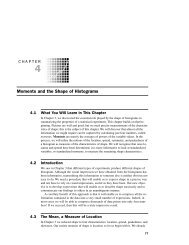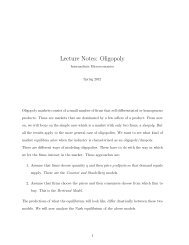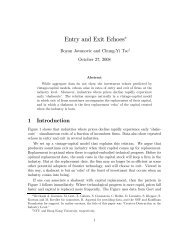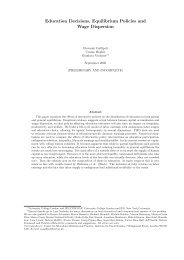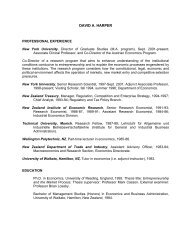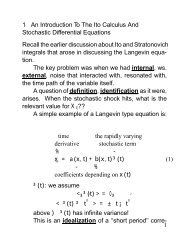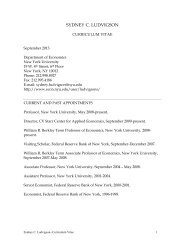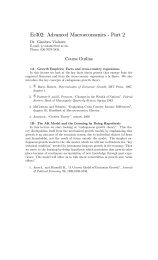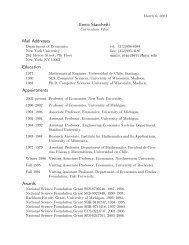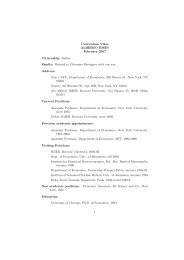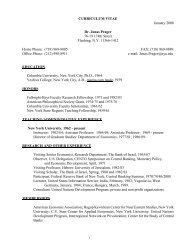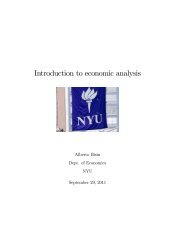On Spatial Processes and Asymptotic Inference under Near$Epoch ...
On Spatial Processes and Asymptotic Inference under Near$Epoch ...
On Spatial Processes and Asymptotic Inference under Near$Epoch ...
Create successful ePaper yourself
Turn your PDF publications into a flip-book with our unique Google optimized e-Paper software.
The rest of the proof is the same, word-by-word, as the proof of Theorem 1 of<br />
Jenish <strong>and</strong> Prucha (2009). Q.E.D.<br />
Proof of Theorem 1: Since the proof is lengthy it is broken into steps.<br />
1. Decomposition of Yi;n<br />
For any …xed s > 0, decompose Xi;n as<br />
where<br />
Let<br />
Yi;n = s i;n + s i;n<br />
s<br />
i;n = E(Yi;njFi;n(s)),<br />
Sn;s = X<br />
i2Dn<br />
s<br />
i;n = Yi;n<br />
s<br />
i;n; e Sn;s = X<br />
i2Dn<br />
s<br />
i;n<br />
s<br />
i;n<br />
2<br />
n;s = V ar [Sn;s] ; e 2<br />
h i<br />
n;s = V ar eSn;s<br />
Repeated use of the Minkowski inequality yields:<br />
Observe that<br />
<strong>and</strong> hence<br />
j n n;sj en;s, j n en;sj n;s: (B.8)<br />
E [E(Yi;njFi;n(s))jFi;n(m))] =<br />
E(Yi;njFi;n(s)); m s;<br />
E(Yi;njFi;n(m)); m < s:<br />
s<br />
i;n E( s i;njFi;n(m))<br />
2<br />
= kYi;n E[Yi;njFi;n(s)] E[Yi;njFi;n(m)] + E[(Yi;njFi;n(s))jFi;n(m)]k2 =<br />
kYi;n E(Yi;njFi;n(m))k2 C (m); if m s;<br />
kYi;n E(Yi;njFi;n(s))k2 C (s) C (m); if m < s:<br />
since by de…nition the sequence (m) is non-increasing. Thus, for any …xed<br />
s > 0, s i;n is uniformly L2-NED on " with the same NED coe¢ cients (m)<br />
as the r<strong>and</strong>om …eld fYi;ng. Furthermore, as shown in the proof of Lemma B.3,<br />
s<br />
i;n is also uniformly L2+ bounded.<br />
2. Bounds for the Variances of P Yi;n <strong>and</strong> P s i;n<br />
First note that exists 0 < B < 1 such that for all n<br />
BjDnj<br />
2<br />
n: (B.9)<br />
Furthermore, in light of Assumption 2, <strong>and</strong> observing that = =(4 + 2 )<br />
= =(2 + ) <strong>and</strong> b =(2+ ) (r) b 2(2+ ) (r) we have<br />
1X<br />
r d( +1) 1 b<br />
r=1<br />
=(2+ )<br />
1X<br />
r d( +1) 1 b =(4+2 ) (r)<br />
r=1<br />
26<br />
1X<br />
r=1<br />
1X<br />
r=1<br />
r d( +1) 1 b 2(2+ ) (r) < 1;<br />
r d( +1) 1 b 2(2+ ) (r) < 1:



